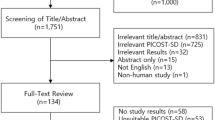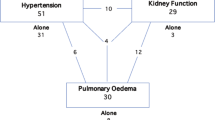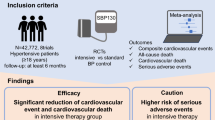Abstract
We investigated whether the combination of medical therapy plus percutaneous transluminal renal angioplasty (PTRA) provides superior clinical outcomes compared to those afforded by medical therapy alone in patients with hypertension due to atherosclerotic renal artery stenosis (ARAS) by conducting a systematic review and meta-analysis of the relevant randomized controlled trials (RCTs). The evaluated outcomes included: (1) cardiovascular disease (CVD)-related mortality, (2) the incidence of CVD events, (3) changes in blood pressure (BP), (4) suppression of renal function decline, (5) changes in the number of antihypertensive drugs used, and (6) serious adverse events. Nine RCTs involving 2275 patients were analyzed, revealing that the combination therapy significantly reduced the number of antihypertensive drugs compared to medical therapy alone (mean difference: –0.42, 95% confidence interval: –0.71 to –0.12). However, there were no significant differences between the combination therapy and medical therapy alone in CVD mortality, the incidence of CVD events, BP changes, suppression of renal function decline, or serious adverse events. The included studies demonstrated a low-to-moderate risk of bias, with performance and detection bias being the most prominent concerns. Together our findings demonstrate that compared to medical therapy alone, the combination of medical therapy + PTRA reduced the number of antihypertensive drugs used but did not improve adverse CVD or renal outcomes. The quality of the included RCTs represents a potential limitation of this analysis.

This is a preview of subscription content, access via your institution
Access options
Subscribe to this journal
Receive 12 print issues and online access
$259.00 per year
only $21.58 per issue
Buy this article
- Purchase on SpringerLink
- Instant access to full article PDF
Prices may be subject to local taxes which are calculated during checkout






Similar content being viewed by others
References
White CJ. The need for randomized trials to prove the safety and efficacy of parachutes, bulletproof vests, and percutaneous renal intervention. Mayo Clin Proc. 2011;86:603–5.
Textor SC, Misra S, Oderich GS. Percutaneous revascularization for ischemic nephropathy: The past, present, and future. Kidney Int. 2013;83:28–40.
De Mast Q, Beutler JJ. The prevalence of atherosclerotic renal artery stenosis in risk groups: A systematic literature review. J Hypertense. 2009;27:1333–40.
Weibull H, Bergqvist D, Bergentz SE, Jonsson K, Hulthen L, Manhem P. Percutaneous transluminal renal angioplasty versus surgical reconstruction of atherosclerotic renal artery stenosis: A prospective randomized study. J Vasc Surg. 1993;18:841–50.
Wheatley K, Ives N, Gray R, Kalra PA, Moss JG, Baigent C, et al. Revascularization versus medical therapy for renal-artery stenosis. N Engl J Med. 2009;361:1953–62.
Bax L, Woittiez AJJ, Kouwenberg HJ, Mali WPTM, Buskens E, Beek FJA, et al. Stent placement in patients with atherosclerotic renal artery stenosis and impaired renal function: A randomized trial. Ann Intern Med. 2009;150:840–8.
Cooper CJ, Murphy TP, Cutlip DE, Jamerson K, Henrich W, Reid DM, et al. Stenting and medical therapy for atherosclerotic renal-artery stenosis. N Engl J Med. 2014;370:13–22.
Shetty R, Biondi-Zoccai GG, Abbate A, Amin MS, Jovin IS. Percutaneous renal artery intervention versus medical therapy in patients with renal artery stenosis: A meta-analysis. EuroIntervention. 2011;7:844–51.
Riaz IB, Husnain M, Riaz H, Asawaeer M, Bilal J, Pandit A, et al. Meta-analysis of revascularization versus medical therapy for atherosclerotic renal artery stenosis. Am J Cardiol. 2014;114:1116–23.
Jenks S, Yeoh SE, Conway BR. Balloon angioplasty, with and without stenting, versus medical therapy for hypertensive patients with renal artery stenosis. Cochrane Database Syst Rev. 2014;2014:CD002944.
Raman G, Adam GP, Halladay CW, Langberg VN, Azodo IA, Balk EM. Comparative effectiveness of management strategies for renal artery stenosis: An opdated systematic review. Ann Intern Med. 2016;165:635–49.
Chen Y, Pan H, Luo G, Li P, Dai X. Use of percutaneous transluminal renal angioplasty in atherosclerotic renal artery stenosis: A systematic review and meta-analysis. J Int Med Res. 2021;49:300060520983585.
Liberati A, Altman DG, Tetzlaff J, Mulrow C, Gøtzsche PC, Ioannidis JPA, et al. The PRISMA statement for reporting systematic reviews and meta-analyses of studies that evaluate health care interventions: Explanation and elaboration. PLoS Med. 2009;6:e1000100.
Minds Manual Developing Committee ed. Minds Manual for Guideline Development 2020 ver. 3.0. Tokyo: Japan Council for Quality Health Care; 2021. Available at: https://minds.jcqhc.or.jp/methods/cpg-development/minds-ma nual/. Accessed Dec. 19, 2024.
Langan D. Assessing heterogeneity in random-effects meta-analysis. Methods Mol Biol. 2022;2345:67–89.
Higgins JPT, Thompson SG, Deeks JJ, Altman DG. Measuring inconsistency in meta-analyses. BMJ. 2003;327:557–60.
Plouin PF, Chatellier G, Darné B, Raynaud A. Blood pressure outcome of angioplasty in atherosclerotic renal artery stenosis: A randomized trial. Essai Multicentrique Medicaments vs Angioplastie (EMMA) Study Group. Hypertension. 1998;31:823–9.
Webster J, Marshall F, Abdalla M, Dominiczak A, Edwards R, Isles CG, et al. Randomised comparison of percutaneous angioplasty vs continued medical therapy for hypertensive patients with atheromatous renal artery stenosis. Scottish and Newcastle Renal Artery Stenosis Collaborative Group. J Hum Hypertens. 1998;12:329–35.
Van Jaarsveld BC, Krijnen P, Pieterman H, Derkx FH, Deinum J, Postma CT, et al. The effect of balloon angioplasty on hypertension in atherosclerotic renal-artery stenosis. Dutch Renal Artery Stenosis Intervention Cooperative Study Group. N Engl J Med. 2000;342:1007–14.
Mazza A, Rigatelli G, Piva M, Rampin L, Cardaioli P, Giordan M, et al. In high risk hypertensive subjects with incidental and unilateral renal artery stenosis percutaneous revascularization with stent improves blood pressure control but not glomerular filtration rate. Minerva Cardioangiol. 2011;59:533–42.
Marcantoni C, Zanoli L, Rastelli S, Tripepi G, Matalone M, Mangiafico S, et al. Effect of renal artery stenting on left ventricular mass: A randomized clinical trial. Am J Kidney Dis. 2012;60:39–46.
Zeller T, Krankenberg H, Erglis A, Blessing E, Fuss T, Scheinert D, et al. A randomized, multi-center, prospective study comparing best medical treatment versus best medical treatment plus renal artery stenting in patients with hemodynamically relevant atherosclerotic renal artery stenosis (RADAR) – One-year results of a pre-maturely terminated study. Trials. 2017;18:380.
Umemura S, Arima H, Arima S, Asayama K, Dohi Y, Hirooka Y, et al. The Japanese Society of Hypertension Guidelines for the Management of Hypertension (JSH 2019). Hypertens Res. 2019;42:1235–481.
Bhalla V, Textor SC, Beckman JA, Casanegra AI, Cooper CJ, Kim ESH, et al. Revascularization for Renovascular Disease: A Scientific Statement From the American Heart Association. Hypertension. 2022;79:e128–e143.
Hicks CW, Clark TWI, Cooper CJ, de Bhailis AM, De Carlo M, Green D, et al. Atherosclerotic Renovascular Disease: A KDIGO (Kidney Disease: Improving Global Outcomes) Controversies Conference. Am J Kidney Dis. 2022;79:289–301.
Sarafidis PA, Theodorakopoulou M, Ortiz A, Fernandez-Fernandez B, Nistor I, Schmieder R, et al. Atherosclerotic renovascular disease: A clinical practice document by the European Renal Best Practice (ERBP) board of the European Renal Association (ERA) and the Working Group Hypertension and the Kidney of the European Society of Hypertension (ESH). Nephrol Dial Transplant. 2023;38:2835–50.
Iwashima Y, Ishimitsu T. How should we define appropriate patients for percutaneous transluminal renal angioplasty treatment? Hypertens Res. 2020;43:1015–27.
Acknowledgements
This study was supported by the Japanese Society of Hypertension guideline committee. We would like to acknowledge Dr. Hisatomi Arima for providing valuable guidance in structuring the manuscript to align with the requirements of a systematic review and meta-analysis.
Author information
Authors and Affiliations
Corresponding author
Ethics declarations
Conflict of interest
The authors declare no competing interests.
Additional information
Publisher’s note Springer Nature remains neutral with regard to jurisdictional claims in published maps and institutional affiliations.
Supplementary information
Rights and permissions
Springer Nature or its licensor (e.g. a society or other partner) holds exclusive rights to this article under a publishing agreement with the author(s) or other rightsholder(s); author self-archiving of the accepted manuscript version of this article is solely governed by the terms of such publishing agreement and applicable law.
About this article
Cite this article
Fujiwara, T., Iwashima, Y., Narita, K. et al. Combination of medical therapy and percutaneous transluminal renal angioplasty versus medical therapy alone for patients with atherosclerotic renal artery stenosis: systematic review and meta-analysis. Hypertens Res 48, 1870–1879 (2025). https://doi.org/10.1038/s41440-025-02166-3
Received:
Revised:
Accepted:
Published:
Issue date:
DOI: https://doi.org/10.1038/s41440-025-02166-3
Keywords
This article is cited by
-
The JSH Morning Hypertension Eradication Program Project
Hypertension Research (2025)



